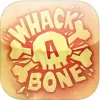Take a look inside 4 images
Whack A Bone
Pros: It's an interactive learning experience with leveled games and a fun theme.
Cons: Learning does not extend beyond memorizing a set of 23 major bones, and the sharing option is confusing.
Bottom Line: Practical, hands-on games get kids engaged in learning about anatomy.
Whack A Bone would work well as a supplement to an anatomy lesson. Students can use the games to practice what they learned in the classroom, or take turns using it as a study tool before an exam. You can motivate students to learn by keeping track of their scores and times, but you'll have to do it on some sort of master classroom list because individual users cannot be entered. Pair up students and have them take turns playing the first game. Then, pair each "winner" (student with the best time) with another winner and have them compete in the next game. Keep going until you have a "bone master." You can also have students use the descriptions of the bones to make flashcards as they make their way through the dragging games.
Whack A Bone is designed to help students learn basic anatomy through interactive games that focus on timed practice. Each game must be unlocked before a player can move on to the next one, so learning is progressive. Kids start with bones in the core of the body, move to arm bones, and then to leg bones. A full skeleton is presented in the final game, so kids can apply what they've learned. There are two levels in each of the first three games. Students start by dragging the bones to the correct position on a labeled model. If they get something wrong, they have to keep trying until they get it right. Then, students tap each bone on the model after a parrot squawks the name of the bone. (You can turn off the parrot sound in the options menu.) If students tap the wrong bone, they must keep tapping and get it right before moving to the next bone. The tapping games are timed, and the best times are stored, which encourages continued practice. However, it would be nice if this feature could be turned off so kids could practice at their own pace if desired.
Whack A Bone gives students an opportunity to learn major bones through interactive play -– dragging and tapping bones on parts of the human body. Kids know immediately if they get an answer wrong, and they have to keep trying before they can move to the next challenge. The learning process is well-designed. Kids have to first learn the positions of the bones using a labeled model as a drag-and-drop target. Then, they must tap the model to identify the bones by name. In the last game, bones are highlighted in the model if students get stuck. Incorrect answers must be corrected as a final step in the learning process.











